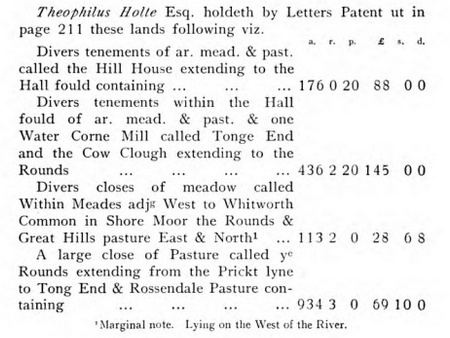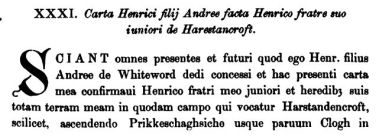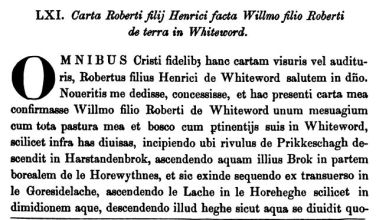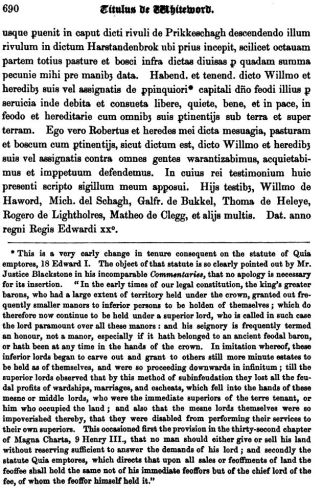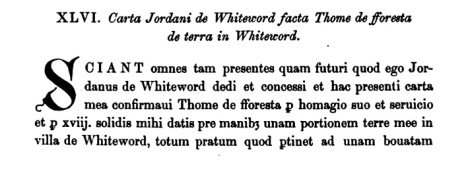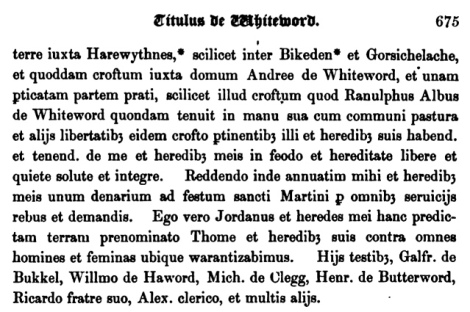There are a few medieval references to iron working in Medieval Salford Hundred, some iron may have come from local “ironstone”.
We have a 14thC. mention of a dispute over iron in Whitworth, involving Whalley Abbey, mentioned in Fishwick’s History of Rochdale. There is also a 15thC. Blackley reference to a shortage of wood for charcoal and associated iron working.
Hundersfield (Rochdale)
It would appear that iron ore could be found in Hundersfield (near Walsden):
” it shall be lawful for Robert and Alice, and the heirs of Alice to assart the whole of that wood, which is on the north side of Lichitheselegh, and there to make meadow or arable land at their will, and to put up forges, and dig for iron and steel ore to supply those forges, wherever they will on the moors and in the woods which belong to the town of Hunewrthefeld. “
‘Lancashire Fines: 12-19 Henry III’, Final Concords for Lancashire, Part 1: 1189-1307 (1899), pp. 54-74. URL: http://www.british-history.ac.uk/report.aspx?compid=52533&strquery=iron Date accessed: 16 July 2012
Local place-names are interesting in Walsden (valley of the Welsh), they include: Pot Oven, Burnt Hills and the water of Ramsden clough is nearby! Inchfield was an old manor and the place-name Ragby is the only by name in the historic Parish of Rochdale!
See the lidar and old maps together below:
https://maps.nls.uk/geo/explore/side-by-side/#zoom=15&lat=53.69178&lon=-2.12654&layers=6&right=LIDAR_DTM_1m
Archaeological evidence
Castleshaw
For research in Castleshaw, see this document here.
Cutler’s Green
Fishwick mentions (History of Rochdale p.44) iron working and slag associated with the Ashworth family at Cutler’s Green in what was the north of Spotland township, Rochdale.
Healey
A probable medieval bloomery was discovered on a bank of the Spodden river above the ruins of Broadley Mill near Healey by a William Grindrod. The site was excavated by JL Maxim from 1917-9
Pilsworth
Medieval iron working (“tap slag”) was revealed in excavations by Norman Tyson of the Bury Archaeological group at Meadowcroft Fold, Pilsworth 1983-4. Further evidence of iron working and associated medieval pottery was found during field walking in 1997.
See also this ADS (Archaeology Data Service) record here.
Holcombe
At Holcombe are the remains of a bloomery, probably of the Tudor period.Trans. Hist. Soc. xxiv, 60; the place is called Cinder Hill.
‘Townships: Tottington’, in A History of the County of Lancaster: Volume 5, ed. William Farrer and J Brownbill (London, 1911), pp. 143-150. British History Online
http://www.british-history.ac.uk/vch/lancs/vol5/pp143-150
[accessed 21 May 2018].
Read about an excavation there at the Holcombe Moor Heritage Group website
Medieval Iron Working Research in Huddersfield, West Yorkshire
Myers Wood, Huddersfield: A geophysical assessment of a medieval iron-working site.
Great research paper by Robert Vernon, with a good technical overview of survey methods.
2004VernonTalkHeritageAward10thSept
Overview of Medieval Iron Working Process from Hungary
Good overview of medieval iron production, including bog iron.
Bog iron
“Bog iron ores form lenses under the ground, which can be found in the beds of brooks, where the brook has eroded one to two metres below ground level (see Thiele and Kecsmár,2013 for details about the geological and archaeometallurgical background of bog iron ores in Somogy County). From these lenses the iron ore can be collected with the help of spades, shovels and pickaxes. The collected iron ore lumps are then washed in a basket in the brook which washes away the dirt and sand.”
https://exarc.net/issue-2014-2/at/soil-iron-product-technology-medieval-iron-smelting
References
(more…)

